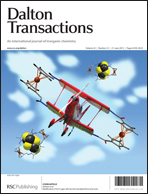The kinetics of chloride substitution from a series of square-planar platinum(II) complexes, viz. [Pt(terpyridine)Cl]+, (Pt1), [Pt{2-(2′-pyridyl)-1,10-phenanthroline}Cl]Cl, (Pt2), [Pt{4′-(2′′′-CH3-phenyl)-2,2′:6′,2′′-terpyridine}Cl]CF3SO3 (Pt3) and [Pt{4′-(2′′′-CH3-phenyl)-6-(3′′-isoquinoyl)-2,2′bipyridine}Cl]SbF6 (Pt4) were studied using a series of five-membered heterocyclic neutral nitrogen donor nucleophiles, viz. pyrazole (Pz), triazole (Tz), imidazole (Im), 1-methylimidazole (MIm) and 1,2-dimethylimidazole (DMIm) under pseudo-first-order conditions in methanol using UV/Visible spectrophotometry and conventional stopped-flow techniques. The observed second-order rate constants, k2, followed a two term rate law kobs = k2[nucleophile] + ks except for DMIm with Pt1, Pt3, Pt4 and Pz, Tz with Pt1. Increasing the π-conjugation in the cis position decreases the rate of chloride substitution by decreasing the π-acceptor property of the terpy moiety. However, increasing the π-conjugation in the cis/trans position increases the rate of substitution by enhancing the π-acceptor property within the ligand framework whereby increasing the reactivity of the metal centre. The observed trend for the reactivity was Pt2 > Pt1 > Pt3 > Pt4. The substitution kinetics was influenced by the basicity of the incoming nucleophiles except for the sterically hindered nucleophile, DMIm. The general trend observed for the reactivity of the nucleophiles is MIm > Im > DMIm > Pz > Tz.


 Please wait while we load your content...
Please wait while we load your content...